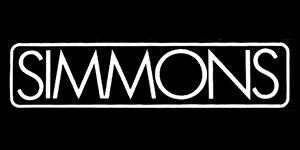
In 1978 Dave Simmons established a company producing electronic drum machines. The brand appeared to be a pioneer of electronic drum manufacturing in Britain. In 1980-1994 Simmons company was a major supplier of electronic kits and in 1999 the rights to the Simmons name were purchased by Guitar Center.
Anyway the music of the 1980s had a definite “Simmons flavour”. Who wasn’t using it? We don’t know, but we know who did and it’s an impressive list: Howard Jones, Kajagoogoo’s Jez Strode, John Keeble of Spandau Ballet, Roger Taylor of Duran Duran, Darren Costin of Wang Chung, Rick Allen of Def Leppard, Thomas Dolby, Prince, Phil Collins, Neil Peart, Bill Bruford, Talk Talk's album The Party's Over, Cameo, Jonzun Crew, Depeche Mode, and Vangelis.
It all started with SDS-5, a.k.a. SDS-V. It was the first viable electronic replacement for acoustic drums. The instrument was engineered by Richard James Burgess and Dave Simmons. Released in 1981 it was actually manufactured by Musicaid. Simmons brand name came up later when Dave founded a new company after Musicaid went broke.
Before that commercial breakthrough there were quite successful 70s which gave us single-pad analog drum synthesizers, including the Pollard Syndrum and the Synare. They were good for a percussion effect but weren’t so much of a drum substitute, though disco music owed them a bit.
SDS-3 came out in 1978 (still within the Musicaid brand). It was an instrument partially replicating Syndrum and Synare. It had 4 drum channels and a noise generator. SDS-4 was a 2-channel version. Musicaid was also the distributor for the Lyricon wind synthesizer. Burgess began collaborating with Dave Simmons when he decided to create something more than just an acoustic drum supplement. SDS-5 had been used by Burgess himself even before it hit the market. The world's first fully electronic drum set, the SDS-V featured the famous hexagonal pads and distinctive sound heard in countless songs by 1980s bands, including Duran Duran and Rush. SDS-5 was about an expandable rack-mountable “drum sound container”, and pad modules for bass drum, snare, and three toms – a standard configuration. The drum machine could interact with a drum sequencer. Its pads (first - polycarbonate and later – soft rubber ones) became a recognizable feature of the 1980s, and Group Centre Inc. help the unit to grow into a big commercial success securing places in US stores.
To assist the musician there was a compact trigger unit developed by Simmons which could be combined with SDS-5. New Order used to apply it.
SDS-6 drum sequencer came a bit later, SDS-7 replaced SDS-5. SDS-7 featured digital sampling sounds on EPROM (8-bit samples, programmable though a little flawed memory).
SDS-8 was released in 1983. The instrument offered an analog architecture featuring a single, non-expandable desktop-style brain with one unalterable factory preset and one custom user preset for each channel. It was a good Simmons option for those who needed analog sounds.
There came out some smaller kits such as SDS-1 - a single pad with a built-in EPROM reader, analog SDS-200 (2 tom system) SDS-400 (4 tom system), and SDS-800 (bass, snare, and 2 tom system).
A digital/analog hybrid was released by Simmons in 1985. SDS-9 featured three digital channels (kick, snare, and rim), analog toms, 40 presets and a built-in digital delay.
In 1987, after the SDS-9, Simmons decided to enter into the high-end professional market and created the revolutionary SDX. The instrument offered something previously unknown - zone intelligence (up to three samples to be assigned to different positional locations on a pad for a more realistic sound) and pad layering (up to nine different samples can be triggered via different strike velocities and positions, selecting samples from a 3 by 3 matrix).
SDX brought Simmons to a decline. It was due to its cost but mainly it happened because drummers opted for acoustics again. In 1989 SDS-2000 was launched featuring some SDX sounds, digital effects and new pads. Before the company’s shut down in 1999 Simmons had another try with drum triggering and MIDI control devices.
Affordable Chinese-manufactured electronic drums came back onto the market after Guitar Center bought the rights to the Simmons name in 2005. Although these instruments were completely different now sporting no resemblance to the classic Simmons machines. Anyway there were some Simmons sounds presented onboard.
Dave Simmons come back to the company in 2017 was good news indeed. The new SD2000 series got announced. The system was rebuilt and is available in two configurations – as a 5-piece unit and a 7-piece one. There will be room to upgrade any of them.

